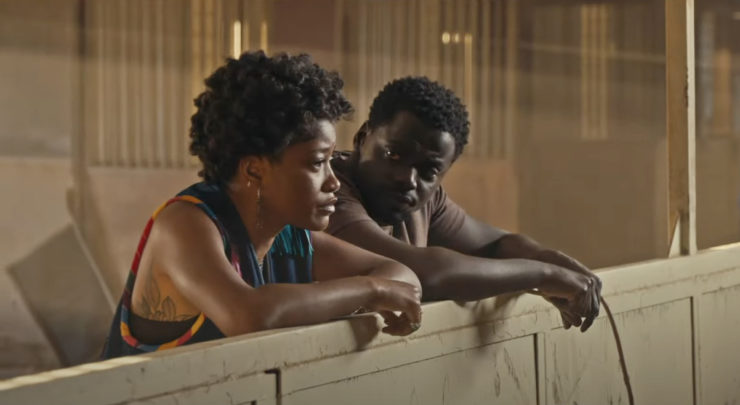[There are going to be lots of spoilers for Jordan Peele’s Nope in this article. Best you watch the film first—which you should, anyway, ‘cause it’s great.]
Film (1965) is playwright Samuel Beckett’s only original work for the screen. Directed by Alan Schneider, the twenty minute, largely silent short features an elderly Buster Keaton—shot only from behind for a good portion of the running time—desperately trying to avoid the gaze of passersby, the pets he keeps in his run-down apartment, and, ultimately and unsuccessfully, the camera (and, by extension, the audience). While Beckett was a master at theater’s most potent tool, dialogue—not just for conveying information, but also for its rhythm and shape as an art in itself—in Film he strips away spoken word to explore the power of the camera. An ominous power, in Beckett’s read—its unflinching gaze compelling characters to cower, and flee, and in one case, presumably, to die.
Jordan Peele’s Nope (2022) begins in the aftermath of a catastrophe. A chimpanzee wanders the trashed ruins of the set of a TV sitcom, pokes at the foot of a prone body, and angrily snatches off the party hat affixed to its head. Then it pauses, looks up, stares straight into the camera. Later in the film, we’ll get a better idea of what has caught the chimp’s attention, but for now, the unsettling impression is that it is staring at us. One could read its glance as dismay, or confusion, or accusation, but the prevailing sense is that our presumed safety as passive spectators has been stripped away. We have been seen, and we are now complicit.
Buy the Book
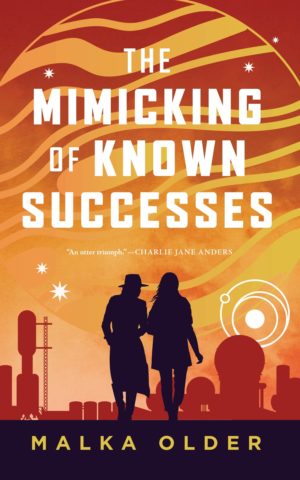

The Mimicking of Known Successes
Peele has stated explicitly that the point of Nope is to explore the idea of spectacle. It’s stated in a title card that opens the film, and cited numerous times throughout by several different characters. For those characters, the salient feature of spectacle is its ability to be exploited. Brother and sister OJ and Em Haywood—played respectively by Daniel Kaluuya and Keke Palmer—struggle to capture on film what first appears to be an Unidentified Aerial Phenomenon haunting their recently-deceased father’s (Keith David) ranch, which not-so-coincidentally grooms horses for use in film and TV productions. Their goal: The mammoth ka-ching they’ll net from selling the image to—for some reason—Oprah.
For their neighbor, the former child star (and survivor of that TV set carnage) Jupe (Steven Yeun), the hovering ship and its predilection for scooping up random farm animals is the key to a new attraction for his tacky, frontier town theme park. For cinematographer Holst (Michael Wincott), recruited by OJ and Em to document the phenomenon, it’s the path to film immortality. All of them are obsessed with how they can leverage spectacle to their benefit, without considering that spectacle might have its own plans.
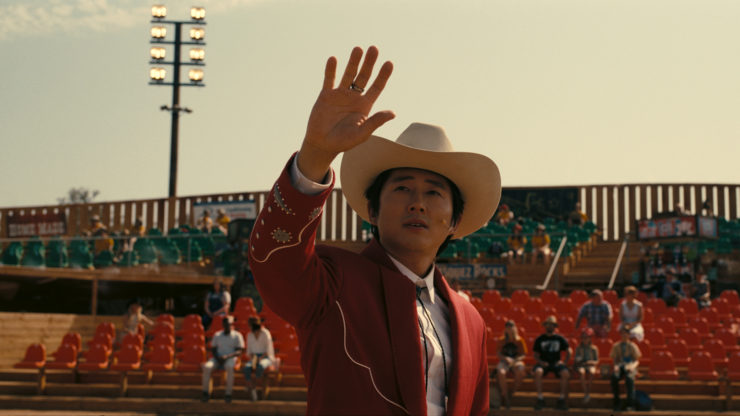
It turns out that the UAP—dubbed “Jean Jacket” by the characters—is neither an Area 51 refugee nor the vanguard for an alien invasion force. Instead, it is some kind of fantastic, airborne predator, with a queasily unique hunting technique: Any creature that gazes upon it becomes its prey. Tables, thus, are turned: Jean Jacket may be the spectacle, but it’s the spectator who gets consumed.
Interesting thing about spectacle, though: It holds a special place in the world of motion pictures. From its very start, film has taken copious advantage of its special capacity for delivering visual thrills. Whether it was the Lumiere Brothers startling audiences with the sight of a passenger train seemingly invading the movie theater, or Edwin S. Porter thrilling filmgoers with a daring train robbery (with, notably, a fade-out in which an outlaw fires directly at the camera), or David Lean capturing the Panavision grandeur of the Arabian desert, or George Lucas wowing soon-to-be Jedi converts with the explosion of the Death Star, the visceral impact of film has always been one of the medium’s most powerful tools.
I suspect Jordan Peele knows this—during the course of Nope he pretty much lays it out through a cataloguing of the various technologies used to capture a moving image, from smartphones to surveillance video to unwieldy IMAX cameras. And I also suspect that a lot of Nope’s visual flare, along with its family ranch mise-en-scene and its horse chase finale, come from Peele’s awareness of another master of filmic spectacle: John Ford. Famous—although not exclusively so—for his work in Westerns, Ford managed to elevate the genre to its own form of art. But aside from bringing nuance to its characters and complexity to its stories, he also strove to capture the scope and grandeur of the American frontier that couldn’t be recorded on a backlot set. In Westerns such as My Darling Clementine (1946) and The Searchers (1956), Ford used the stark beauty of Monument Valley as a striking canvas to stage his dramas. Even without the benefit of Panavision, the soaring stretch of unconquered land, punctuated with towering buttes, formed a grand panorama against which to chronicle the exploits of John Wayne and Henry Fonda.
While the scrubby desert of northern Los Angeles County doesn’t provide quite as impressive vistas, Nope’s director of photography Hoyte Van Hoytema does manage to capture a compelling vastness of space, uncommon for a monster movie and all the better for Peele to open up his settings—it’s a particularly useful tool when you want to emphasize a fragile humanity’s vulnerability to a strange, imposing menace.
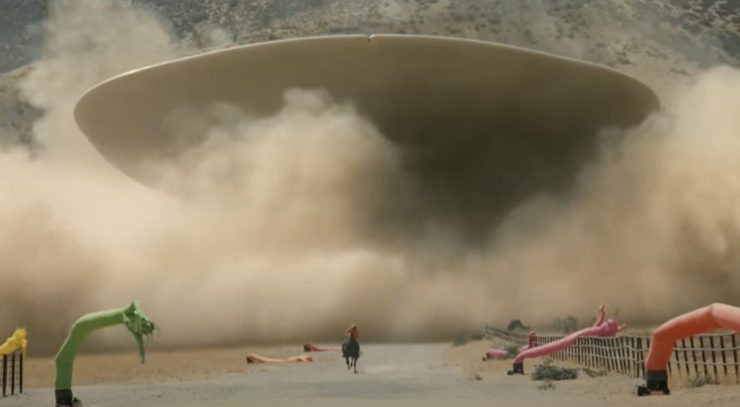
It’s that sense of vulnerability, though, that reveals Nope’s key, conceptual inversion: What happens when one stops partaking of spectacle, and becomes spectacle oneself? The image of standing alone and exposed, the target of a soulless entity that desires nothing more than to feast upon you, is not just the stuff of creature features—Peele makes that point blatant when OJ and Em have to contend with the intrusion of a TMZ reporter, a media parasite in a mirrored helmet (reminiscent of the mirrored special effects globe that spooks a Haywood horse at the beginning of the film), who toodles onto the scene on an electric motor bike, asking obnoxious questions and wielding a ridiculous, multi-camera rig.
And you have to wonder whether Peele—as one half of the comedy team behind a highly-praised and occasionally radical sketch show, and then as an “overnight” sensation for his strikingly original SF/horror films—might not be trying to say something about the experience of becoming a spectacle himself. About how the admiration can abruptly turn to condemnation (i.e.: the praise for Get Out and Us, contrasted with the long knives wielded for Peele’s update of The Twilight Zone), about how a loving public might become downright bestial, about how even if public opinion doesn’t turn, the flood of attention can threaten to consume the unwary whole.
But then, flip the concept again, and consider the situation where one is cognizant of the dangers of being beheld, and embraces them anyway, because there is no other choice. At first glance, it may seem as if race isn’t a major factor for OJ and Em as they struggle to keep the family business afloat. The Black-owned Haywood Ranch has been passed down from generation to generation and, it is implied, has had a long-standing relationship with Hollywood through the decades. But the journey to that respectability is a telling one: At the beginning of the film, we’re introduced to Em through a speech she delivers to a movie crew, explaining how the first motion picture—Eadweard Muybridge’s documentation of a horse at full gallop—was made possible through the participation of a Black jockey. That jockey, within the film’s reality, was Em’s ancestor, but anonymous in the view of history. Implied in that anecdote is a lesson: That the journey from institutionalized invisibility to full inclusion (or mostly full inclusion—we’re still on that journey) doesn’t come about because people remain in the shadows. Change only comes when people stand up, make their voices heard, make their faces seen.
Make themselves a spectacle.
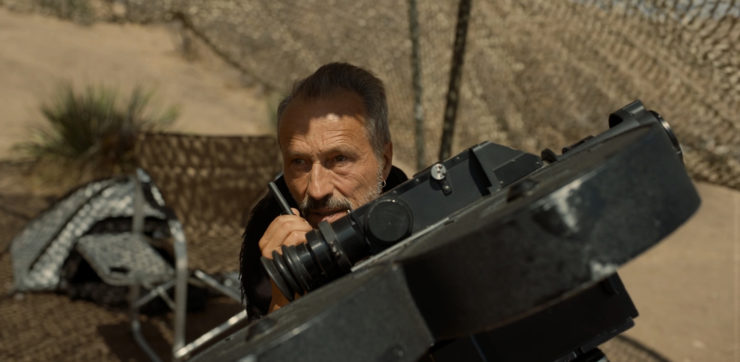
But as the marchers in Birmingham knew, as Rosa Parks knew, as the BLM protesters outside St. John’s Church knew, to be seen is to court the danger of becoming a target. At the end of Nope, OJ deliberately draws the attention of Jean Jacket, riding a horse beneath the creature while wearing a sweatshirt with mammoth eyes affixed to its hood (just by coincidence, the comical gaze bears a striking resemblance to the owlish glare sculpted into a piece of ornate furniture that Buster Keaton confronts in Film). It’s that unyielding stare that is the beginning of the end for Jean Jacket, and for good reason. One doesn’t vanquish a foe by hiding in the corner. You have to put yourself out there, court exposure, be seen so your adversary knows that it is seen, as well.
Maybe I’m overthinking Jordan Peele’s intent. Maybe all he wanted to do was to look at moving picture’s natural bent toward spectacle and how, over the span of a century-plus, it has spawned a culture that feeds upon sensation, that can’t get enough, that needs the thrills to be ever bigger, more dynamic, more fantastic, unto infinity, whatever the cost to the object of consumption. On that level alone, as both love letter to the power of film and cautionary missive about the culture it shapes, Nope stands heads-and-(horse)-tails above most monster-on-the-loose movies. But if in the process, it also lets us see beyond the world of film to something larger, something that can transform society, so much the better.
It doesn’t necessarily hold that the natural path of media is toward exploitation. A camera is just a machine, it does not judge what it records. We’re human, though, and what we consume, and what we do afterward with what we consume, can be dedicated to a higher purpose. Spectacle is fine within its own little corner of the media landscape—I am not immune to the rush delivered by a pure deployment of cinematic artistry. But there should always be something more than just kick-ass visuals, and it should always be readily accessible.
* * *
As is my nature, I read Nope in the context of film history and how the medium has morphed into what we consume now. But that certainly isn’t the only message one can derive from the film. JR. Forasteros has a completely different take, looking into Nope’s numerous biblical references. And maybe you came away with yet another interpretation, or just think that my read is wrong, wrong, wrongedy wrong-wrong-wrong. If so, we’ve got a comments section below for you to record your views. Just remember what you’re doing when you make yourself visible with your post—don’t make a spectacle of yourself, and let’s try to avoid devouring each other. Please keep your feedback friendly and polite.
Dan Persons has been knocking about the genre media beat for, oh, a good handful of years, now. He’s presently house critic for the radio show Hour of the Wolf on WBAI 99.5FM in New York, and previously was editor of Cinefantastique and Animefantastique, as well as producer of news updates for The Monster Channel. He is also founder of Anime Philadelphia, a program to encourage theatrical screenings of Japanese animation. And you should taste his One Alarm Chili! Wow!










